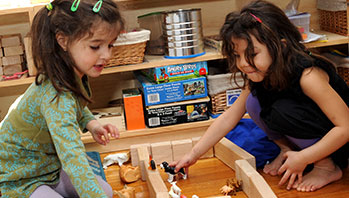- aprons
- blocks
- grocery store fliers
- labeled empty food cans and cartons
- paper bags
- pictures of food
- plastic toy food
- play coins
- play paper money
- shoe boxes
- toy cash register
- grocery store
MA Standards:
Speaking and Listening/SL.PK.MA.5: Create representations of experiences or stories (e.g., drawings, constructions with blocks or other materials, clay models) and explain them to others.
Head Start Outcomes:
Approaches to Learning/Initiative and Curiosity: Demonstrates flexibility, imagination, and inventiveness in approaching tasks and activities.
Logic and Reasoning/Reasoning and Problem Solving:Classifies, compares, and contrasts objects, events, and experiences.
Logic and Reasoning/Symbolic Representation: Represents people, places, or things through drawings, movement, and three-dimensional objects.
PreK Learning Guidelines:
English Language Arts/Language 2: Participate actively in discussions, listen to the ideas of others, and ask and answer relevant questions.
Grocery Store #1

© Commonwealth of Massachusetts, Department of Early Education and Care (Jennifer Waddell photographer). All rights reserved.
Skill Focus: Environmental Print, Concepts of Print, Listening and Speaking, Sorting and Classifying, Vocabulary
Have children help you create a pretend grocery store with blocks and bins. Begin with a conversation about grocery stores. Ask questions such as,
- What is a grocery store?
- What do they sell at a grocery store?
- What kinds of things do we need to create a grocery store? (toy food, shelves, cash register, signs, prices, shopping cart, bags, etc.)
- Who works in a grocery store?
- What do we want to call our store? Vote on a name and help children make a big sign to display.
As children set up the store, encourage them to sort and organize the toy foods into two categories: foods that come from plants and foods that do not come from plants. Have children write prices on the food items. Encourage children to look at and “read” the labels on the cans and boxes. Ask, What is this? How do you know what’s inside? Do you recognize any letters or words on this label? Talk about how the pictures, colors, and letters help children identify what is inside.
The grocery store will continue into the next two weeks. Gradually add materials as children’s play in the store becomes more specific and detailed.
Educator Tip: If possible, begin with a visit to a real grocery store to do some research on what is in a grocery store. You may even be able to have a real store manager donate a few realistic supplies such as sale signs.
